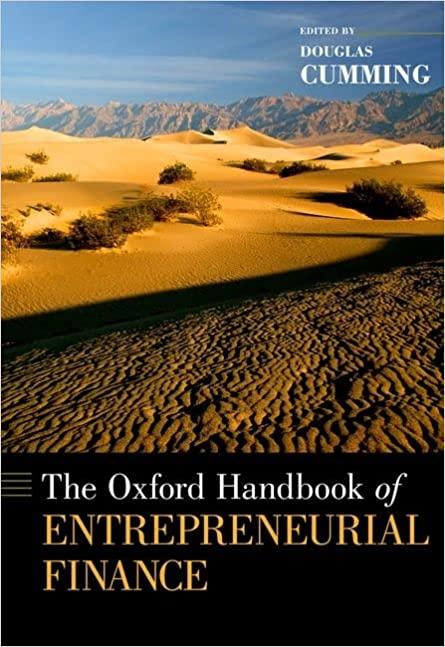Question
Assume the risk-free rate is 4% ( = 4%), the expected return on the market portfolio is 12% (E[] = 12%) and the standard deviation
Assume the risk-free rate is 4% ( = 4%), the expected return on the market portfolio is 12% (E[] = 12%) and the standard deviation of the return on the market portfolio is 16% (= 16%). All numbers are annual. Assume the CAPM holds. a. What are the expected returns on securities with the following betas? (i) = 1.0 E[] ________________ (ii) = 1.5 E[] ________________ (iii) = 0.5 E[] ________________ (iv) = 0.0 E[] ________________ (v) = -0.5 E[] ________________ b. What are the betas of securities with the following expect returns? (i) E[] = 12% ________________ (ii) E[] = 20% ________________ (iii) E[] = - 4% ________________ c. What are the portfolio weights (in the risk-free asset and the market portfolio) for efficient portfolios (portfolios on the efficient frontier) with expected returns of (i) E[] = 8% ________________, _______________ (ii) E[] = 10% ________________, _______________ (iii) E[] = 4% ________________, _______________ (iv) E[] = 24% ________________, _______________ d. What are the portfolio weights (in the risk-free asset and the market portfolio) for efficient portfolios (portfolios on the efficient frontier) with standard deviations of (i) = 4% ________________, _______________ (ii) = 20% ________________, _______________ (iii) = 16% ________________, _______________ e. What are the correlations between the portfolios in (i) Q.1c(i) and Q.1c(iv) , ________________ (ii) Q.1d(i) and Q.1d(ii) , ________________ f. Can securities or portfolios with the following characteristics exist in equilibrium, assuming the CAPM holds (answer yes or no): (i) expected return 0%, standard deviation40% _____________ (answer yes or no) (ii) expected return 9%, standard deviation 9% _____________ (answer yes or no) (iii) expected return 34%, standard deviation 70% _____________ (answer yes or no) g. A stock has a current price of $40/share. (i) If the beta of the stock is 1 ( = 1.0) and the stock pays no dividends, what is the expected price in 1 year? E $________________/share (ii) If the beta of the stock is 1 ( = 1.0) and the stock is expected to pay a dividend of $4/share at the end of the year, what is the expected price in 1 year (after the payment of the dividend)? E $________________/share (iii) If the beta of the stock is 2 ( = 2.0) and the stock pays no dividends, what is the expected price in 1 year? E $________________/share (iv) If the beta of the stock is 2 ( = 2.0) and the stock is expected to pay a dividend of $4/share at the end of the year, what is the expected price in 1 year (after the payment of the dividend)? E $________________/share
h. For a moment (but just a moment) assume that the CAPM may not hold. In other words, alpha () is non-zero. If a non-dividend paying stock has a current price of $50/share and an expected price in 1 year of $60/share (based on your personal analysis of the companys prospects). (i) What is the alpha() of this stock if the stocks beta of 1 ( =1.0)? (ii) What if the beta is 2 ( = 2.0)? (iii) What if the beta is 3 ( = 3.0)?
Step by Step Solution
There are 3 Steps involved in it
Step: 1

Get Instant Access to Expert-Tailored Solutions
See step-by-step solutions with expert insights and AI powered tools for academic success
Step: 2

Step: 3

Ace Your Homework with AI
Get the answers you need in no time with our AI-driven, step-by-step assistance
Get Started


